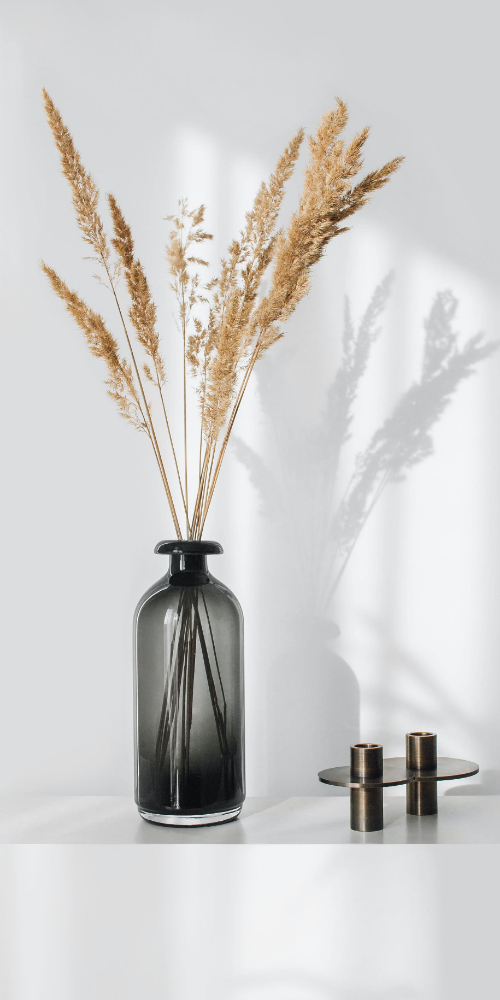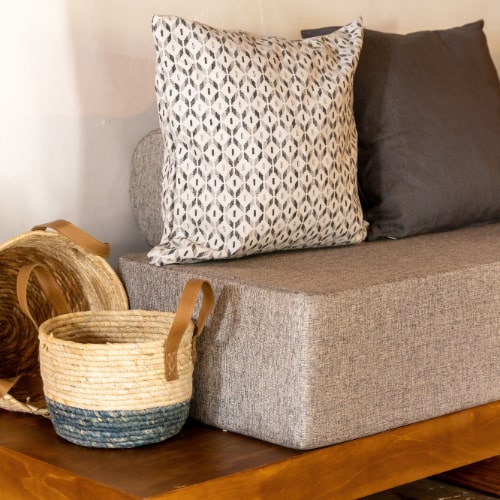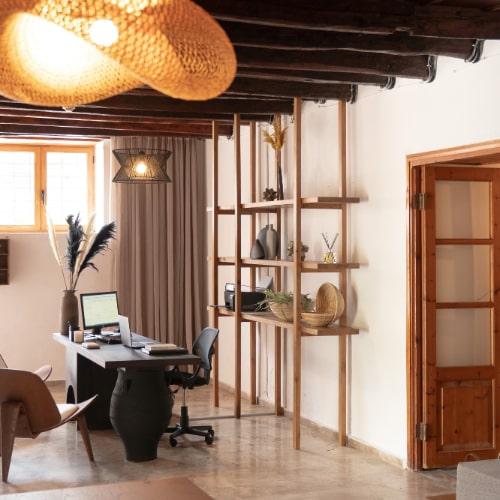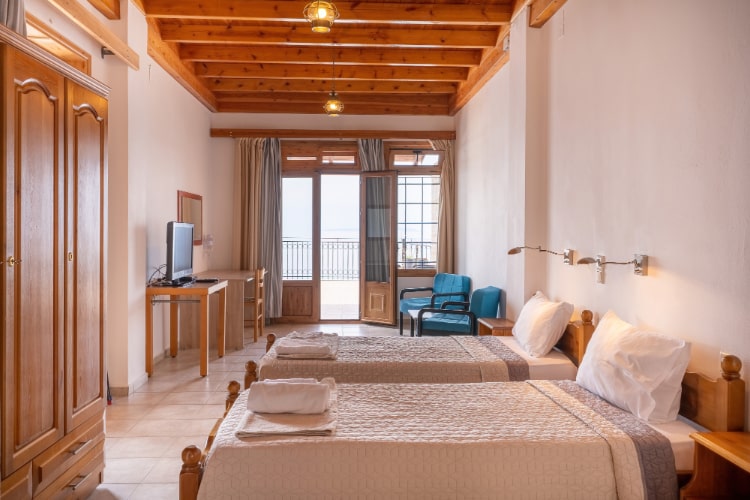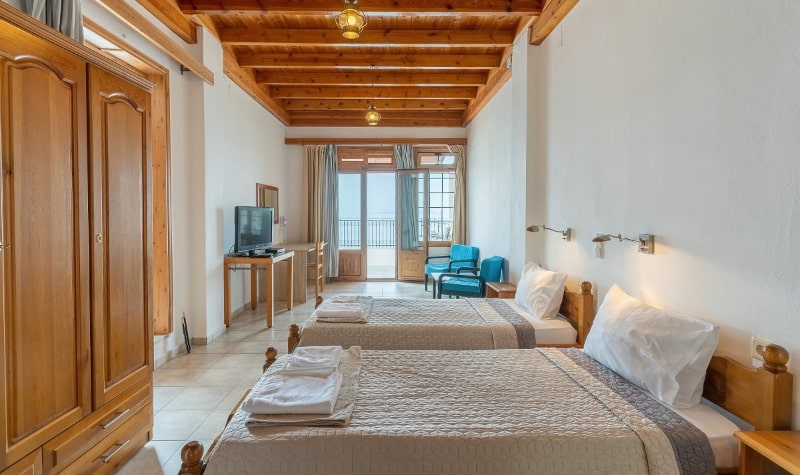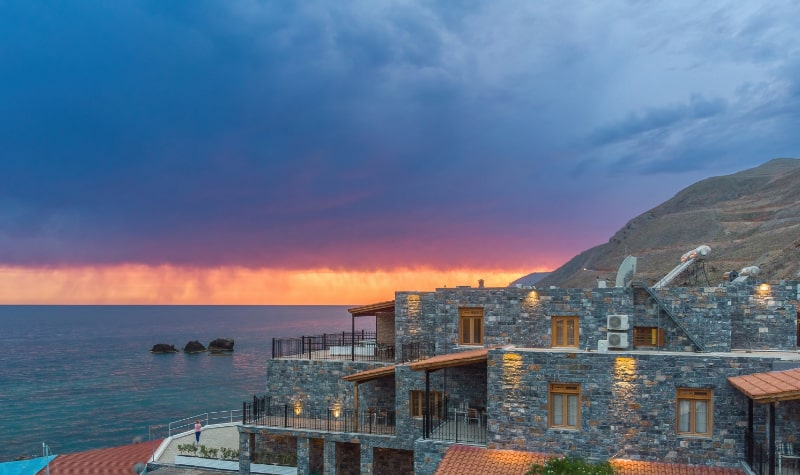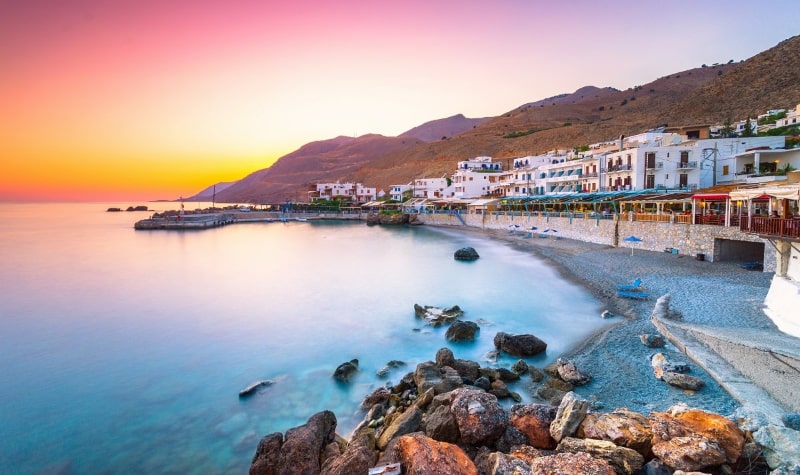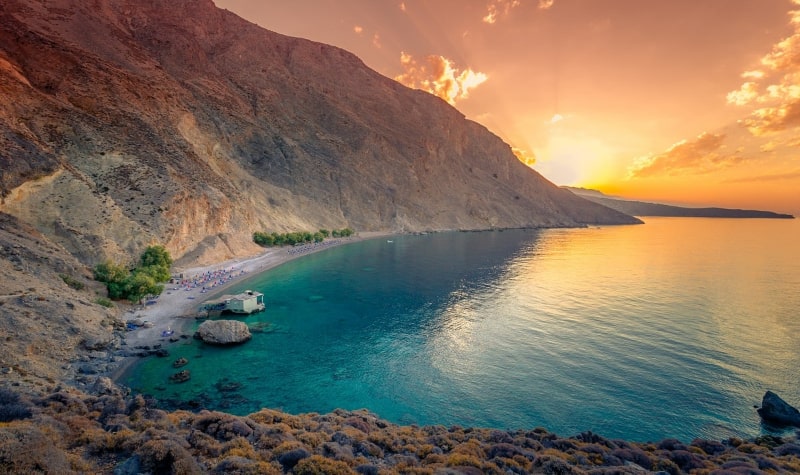Chora Sfakion (Sfakia)
Where the mountains meet the sea
Chora Sfakion is a charming village between the foothills of the White Mountains and the Libyan Sea. Read our complete guide to find out everything you should know about our village!
An excellent starting point to explore Southern Crete

Chora Sfakion, or just Sfakia, is a small seaside village hidden in a remote and mountainous region of southern Crete. Legendary for its inhabitants’ resistance efforts and fiercely independent spirit throughout Crete’s bloody history, it is a hardy land with just as hardy, but also friendly and hospitable, people.
This is not your average charming village, a mass tourism center with choke-full beaches and vibrant nightlife. If your idea of a vacation is to relax on some big, crowded beach all day, then hit a club at night, you will not find what you seek here. But should you have a wilder, more adventurous side, read on. On Crete’s south coast, where the mountains meet the sea, there are many hidden gems to uncover.
From the untamed nature of the White Mountains to the quiet local beaches and the rich local history, Chora Sfakion can be your base and starting point for the experience of a lifetime.
The Village
Nestled between the White Mountains and the Libyan Sea, Chora Sfakion lies about 75km away from the city of Chania, on the south coast of Crete. One of the largest settlements in the remote and mountainous region of Sfakia, the small fishing village has been hailed as a home of independence, its rough surroundings and tough inhabitants ensuring it would always repel invaders.
Lacking the bustling activity of other popular holiday destinations, the village is nonetheless ideal for anyone wishing to explore southern Crete. The nearby gorges will satisfy any hiker and nature enthusiast while the surrounding beaches offer rest and relaxation away from the noise and crowds of the busy north.
The people of Sfakia are also known for their hospitality as much as they are for their fighting spirit and long struggles against oppression. This is a region that never submitted to any conqueror and produced true heroes. It is also a region that welcomes and embraces travelers and visitors. And there is little more satisfying than coming back from a long hike or a day of thrills to a cozy, relaxing atmosphere, hearty people, and, of course, good food. We are talking of Crete’s finest, after all.
Sfakia Weather and Climate
You’d expect Greece and especially Crete to have sunny, warm weather and you’d be right. The sun graces the south coast all year round and even the winter months are mild.
May to October in particular offer the best opportunities, with the early and late weeks seeing temperatures of 25 to 30 degrees Celsius, ideal for walks, hikes, and even a visit to the beach. On the other hand, July and August are true, peak greek summer, with barely a cloud in sight, temperatures in the mid-30s, and an open invitation to tan, take a swim in the sea, and let the worries of everyday life wash away for a while. Just take care not to get sunburnt.
Yes, summer lasts for six months, here in Crete’s south coast. So take your pick. You won’t regret your choice, whatever it may be.
How to Get to Sfakia
With all the talk of mountains, conqueror-discouraging land, and rough terrain, you might be thinking that the only way to reach this elusive place is through reef-strewn dangerous seas or maybe via a private helicopter. But worry not. There are roads connecting Chora Sfakion to the rest of the world. Just be prepared for a bit of a road trip.
Ideally, you will arrive in Crete through either Chania’s Daskalogiannis Airport or the nearby port of Souda. As mentioned earlier, Chania is about 75km away and the airport is at a similar distance, a drive of around 73km to get here. Don’t expect to hit high speeds on the mountain roads, however. It will take you around an hour and a half to reach the village.
Souda is slightly closer, at 62km. Ultimately, however, you’ll be driving the same road, so expect to be in the car for 75 minutes or so.
If you do not have a car, there are also buses making the same journey, albeit at a slower pace, so add thirty minutes to one hour to your schedule.
Car or bus are your options if you arrive at Heraklion rather than Chania as well. Keep in mind, however, that the city’s N. Kazantzakis airport and seaport are twice as far, at 146km. It takes 2 hours and 15 minutes to cover the distance by car and even longer by bus, so unless you’re planning on staying in Heraklion proper for a while, it is better to go with the Chania option.
You can find information on Chania’s bus services here and on Heraklion’s here.
Things to Do in Hora
When you’re visiting Sfakia, you do not do so for the huge, popular beaches, the museums, or the bars. You’re here for the adventure and the thrill. And there is plenty of that to go around. That being said, Chora Sfakion is still nice for an afternoon walk and, most importantly, for the great cuisine. It will be your base of operations, after all. The village’s taverns offer excellent food, wine, and local dishes to close out your every day in the best possible manner.
But let us have a look at the surrounding area now.
Chora Sfakion is far from the only settlement hiding in this remote and mountainous region. The nearby village of Anopolis, home of the Cretan hero Daskalogiannis, is a picturesque little place looking down on the south coast, with a great view of the region and some nice local delicacies to sample. There is also the Askifou plateau, a hidden paradise of green fields that, aside from the villageσ and farms, also has a small museum with an impressive collection of memorabilia from the German invasion of Crete during the Second World War.
Frangokastelo, meaning “Fort of the Francs”, is another interesting place to visit. As you’d expect, there is a ruined fort there, built by the Venetians in the early 1370s. The site has been used as a base of Cretan revolutionaries through the years but is more well-known for the Drosoulites (“dew-men”) phenomenon, human-shaped shadows appearing sometimes in the morning fog during late May. Tradition maintains that these are the shadows of Greeks under Hatzimichalis Dalianis, who fought here against the Turks in a bloody battle on May 18th, 1828. Since then, their spirits gather every year to re-enact the clash, ever vigilant in defending the fort. It is said that even Turkish and German soldier patrols have mistaken this ghost army for real and fled or fired against it.
But maybe you’re here to hike, in which case, you’re in luck. The E4 hiking trails pass through the region and seemingly every village in the area is near the beginning of a mountain path, with the White Mountains offering enough to satisfy even the most demanding of trekkers. The world-famous Samaria Gorge, with its incredible wildlife and 15km walk, is the most popular of these trails, but far from the only one. The nearby Imbros Gorge might be less well-known but is every bit as beautiful and nowhere near as exhausting to traverse. And if you’re feeling brave enough, you can visit the Aradena Gorge and bungee jump from its 138m bridge, an experience sure to get anyone’s blood pumping.
You might be thinking, however. Shouldn’t you be going for swims while in Greece and was there no talk earlier about this being a seaside village? You’d be correct on both counts and luckily, there is plenty of sea to go around. A number of areas, like the remote coastal villages of Loutro and Agia Roumeli or the nearby island of Gavdos, can be reached primarily or exclusively via ferry boat, plenty of places are offered for snorkeling and there are many pebbly beaches nearby as well as a number of sandy ones. In fact, the beaches, small, quiet, and hidden, are numerous enough that some claim you can find your own private beach just by walking along the coast. If you want to find out more about them, read on.
Beaches near Chora Sfakion
There are lots of beaches in the area around Chora Sfakion, close enough to reach through some walking or a short car drive.
You will mostly find pebbly beaches in the area and that is true of the village’s prime one, Vrissi. It is a small cove with clear water west of the settlement and your most likely destination during laid-back days if you just want to get to the sea with as little hassle as possible.
2km away lies Iligas, one of the best beaches in the region. It is actually three beaches, with a main, “commercial” one reachable on foot while two more lie further down the coast if you’re willing to swim or row for a couple of hundred meters. Not even the main beach is ever especially crowded and the area is gorgeous, with seaside caves and crystal-clear waters. It is also on the way to Anopolis, so you can stop by on your journey to or from there. Or you can just take a quick walk from Chora Sfakion at any time.
Ammoudi is of a similar nature. Less than 2km east of Sfakia, it is notable for its various geological formations, primarily the Fokia cave which houses a beach of its own in its depths. Fokia means “seal” and you might even get lucky and spot one, as there are still a few in the area.
A bit further off east is Filaki. This and the nearby Agios Charalambos, between Filaki and Ammoudi, are primarily nudist beaches, owing to the nearby nudist hotel Vritomartis.
One last, particularly noteworthy beach, is Glyka Nera (sweetwater beach) to the west of Chora Sfakion. It is accessible only by ferry boat or with a 30-minute walk over cliffs from the village (it is well-maintained and safe, however, so no worries). Once ranked by the London Times as one of the 20 most beautiful beaches in Europe, Glyka Nera is hidden at the feet of the mountains which give the surroundings a majestic air and its deep blue waters are the kind of color you’ll see in travel guides, only real.
Take care, however. Glyka Nera means “sweet waters” and comes from the local springs of clean water (you can even drink the water from some of the ponds right next to the sea) but said springs also mean that the sea is constantly refreshed with cold water and its temperature is relatively low, even in the height of summer.
As you can see, even if it is not a center of mass tourism, there are plenty of things to do and places to visit in Sfakia. With Chora Sfakion lying at the ideal cross of all those locales, both the mountain trails and the Libyan Sea’s beaches being right next to the village, it is the best place to stay while exploring the region.
So book a room, set up your schedule and get ready to experience all Sfakia has to offer.


